Being a homeowner comes with the responsibility of maintenance and occasional plumbing repair services. Leaky faucets and clogged drains can be especially inconvenient, and if left unaddressed, can result in costly damage. For instance, a leaky faucet can waste a significant amount of water, leading to increased utility bills. Moreover, neglecting such issues can lead to more severe problems, such as water damage and mold growth.
Fortunately, many plumbing issues can be resolved through simple DIY methods or by hiring professionals who specialize in plumbing repair services. By addressing these issues promptly, homeowners can avoid more extensive and expensive repairs down the line.
Key Takeaways
- Regular maintenance can significantly reduce the risk of clogs and other plumbing issues.
- DIY methods can provide temporary relief but often fail to address the root cause of the problem.
- Professional plumbing services can offer long-term solutions to common plumbing problems.
- Understanding pipe material options can affect durability and maintenance needs.
- Water pressure optimization is essential for the efficient operation of a home’s plumbing system.
Understanding Common Plumbing Issues
Understanding the most common plumbing issues is crucial for homeowners to maintain their properties effectively. Plumbing problems can range from minor annoyances to major emergencies, and being aware of their causes and solutions can save time and money.
Leaky Faucets
Leaky faucets are not only annoying due to the constant dripping sound, but they can also waste a significant amount of water over time. The causes often include worn-out washers or O-rings, and in some cases, the issue might be with the faucet’s cartridge. For fast plumbing solutions, identifying the type of faucet and the right replacement parts is essential.
Running Toilets
A running toilet can be a significant source of water waste, increasing utility bills unnecessarily. The most common causes include issues with the flapper, problems with the fill valve, or an improperly adjusted flush mechanism. Homeowners can benefit from affordable plumbing fixes by diagnosing these issues correctly and making the necessary adjustments or replacements.
Clogged Drains
Clogged drains are another common plumbing issue that can cause inconvenience and potentially lead to more severe problems if not addressed. Hair, soap scum, and grease are typical culprits behind clogged drains. Understanding the cause and applying the appropriate DIY solution, such as using a plunger, baking soda, and vinegar, or a drain snake, can resolve the issue efficiently.
By understanding these common plumbing issues and their causes, homeowners can take the first step towards resolving them effectively. This knowledge not only helps in saving water and reducing utility bills but also in maintaining the overall integrity of the plumbing system.
Essential Tools for DIY Plumbing
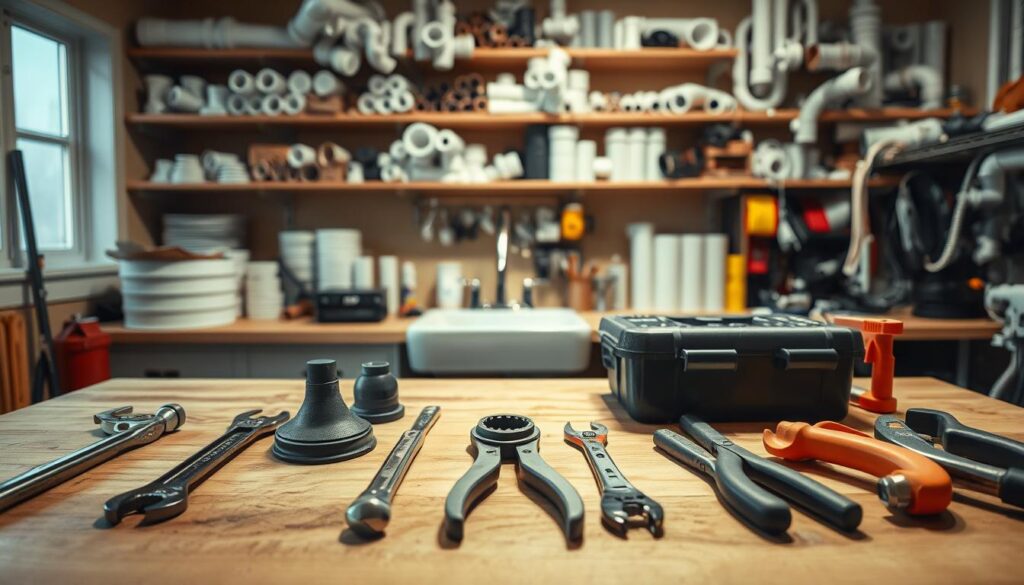
When it comes to DIY plumbing repairs, having the right tools is not just a convenience, it’s a necessity. As emphasized by experts, “Having the right tools for the job makes all the difference in the world when it comes to DIY plumbing.”
To get started, it’s essential to understand the types of tools required for various plumbing tasks. For instance, a reliable plumber’s wrench is indispensable for tightening and loosening fittings. For more complex tasks, having a variety of wrenches and pliers can make a significant difference.
Wrenches and Pliers
Wrenches and pliers are fundamental to any DIY plumbing toolkit. They come in various types, each designed for specific tasks. For example, adjustable wrenches can be used for a range of pipe sizes, while needle-nose pliers are perfect for gripping small objects in tight spaces.
Pipe Cutters
Pipe cutters are another crucial tool for DIY plumbing. They allow you to cut through pipes cleanly and efficiently, which is essential for making repairs or installing new fixtures. For those who need professional assistance, an efficient plumbing repair company can provide expert help.
Plumber’s Tape
Plumber’s tape, also known as Teflon tape, is used to create a watertight seal on threaded pipe connections. It’s a simple yet effective tool that can prevent leaks and ensure that your plumbing system operates smoothly. For urgent repairs, knowing that you can rely on a service that offers same-day plumbing repairs can be a significant relief.
In conclusion, equipping yourself with the right tools is a critical step in DIY plumbing. By understanding the role of each tool and having them at your disposal, you can tackle plumbing issues with confidence.
Dealing with Clogs in Sinks
A clogged sink can be a significant inconvenience, but understanding how to address it can save you time and money. Clogged sinks are often the result of grease buildup, food particles, or other debris accumulating in the pipes.
Using a Plunger Effectively
One of the simplest and most effective ways to clear a clogged sink is by using a plunger. To do this, ensure the plunger is properly seated over the drain, then push down slowly and steadily until you feel resistance. Plunge vigorously several times to loosen the clog, and check if the water drains freely.
Baking Soda and Vinegar Method
For a more natural approach, try the baking soda and vinegar method. Pour 1/2 cup of baking soda down the drain, followed by 1 cup of vinegar. Let the mixture sit for a few hours or overnight, then pour hot water down the drain to rinse. This method is environmentally friendly and can be effective for minor clogs.
Snaking the Drain
If the clog persists, it may be necessary to snake the drain. Use a drain snake (auger) to remove any blockages further down the pipe. Feed the cable into the drain and rotate it as you push it further into the pipe. Once you feel resistance, pull the cable back out, bringing the clog with it. For more complex clogs, consider consulting a professional for emergency plumbing services.
By following these steps, you can often resolve sink clogs on your own. However, if you’re unsure or if the problem persists, it may be time to call in a professional for plumbing repair services.
Fixing a Leaky Faucet
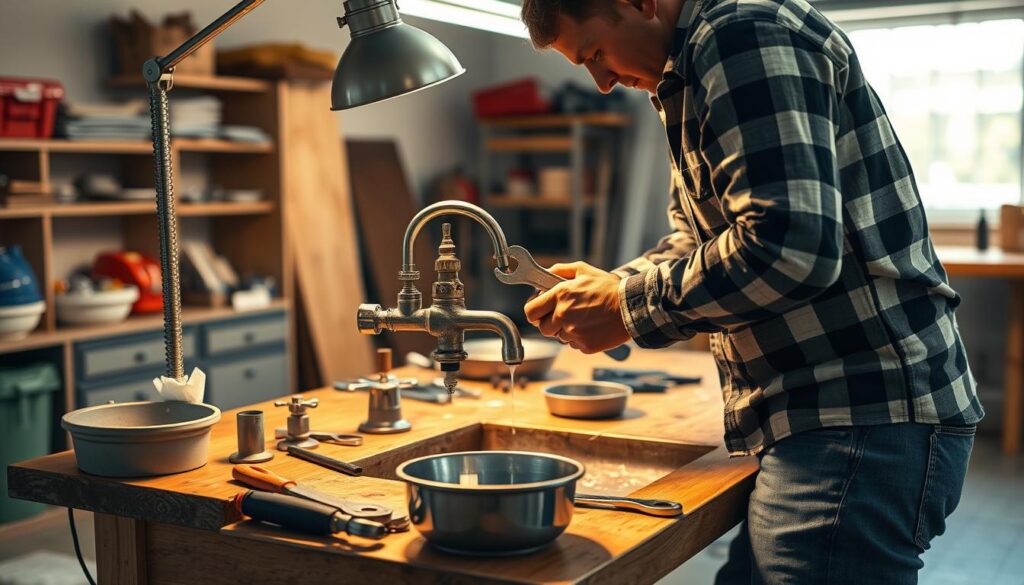
Fixing a leaky faucet is a straightforward DIY task that can save homeowners a significant amount of water and money. Leaky faucets are not only annoying due to the constant dripping sound, but they also waste a considerable amount of water over time.
Identifying the Type of Faucet
Before you start repairing a leaky faucet, it’s essential to identify the type of faucet you have. The most common types include compression faucets, cartridge faucets, ball-and-socket faucets, and disc faucets. Each type has its unique characteristics and requires different repair approaches.
For instance, compression faucets are the most common and have separate handles for hot and cold water. They work by compressing a rubber washer against a valve seat to stop the water flow. On the other hand, cartridge faucets have a single handle and use a cartridge to control water flow and temperature.
Replacing Washers and O-Rings
One of the most common causes of a leaky faucet is worn-out washers or O-rings. For compression faucets, replacing the washer can often fix the leak. This involves disassembling the faucet handle, removing the old washer, and installing a new one.
For faucets with O-rings, such as cartridge or ball-and-socket faucets, inspecting and replacing the O-rings can resolve the issue. It’s crucial to turn off the water supply before starting the repair to avoid any water damage.
Adjusting Faucet Cartridges
If your faucet has a cartridge, adjusting or replacing it might be necessary. Cartridge faucets can leak due to worn-out or misaligned cartridges. To fix this, you may need to remove the cartridge, clean it, or replace it if it’s damaged.
For more complex faucet types, consulting the manufacturer’s manual or seeking professional help might be necessary. For emergency situations, consider reaching out to emergency contractor services for assistance.
| Faucet Type | Common Leak Cause | Repair Complexity | DIY Feasibility |
|---|---|---|---|
| Compression | Worn-out washers | Moderate | High |
| Cartridge | Damaged or misaligned cartridges | Moderate to High | Moderate |
| Ball-and-Socket | Worn-out O-rings or seals | High | Low to Moderate |
| Disc | Damaged ceramic discs | High | Low |
By understanding the type of faucet you have and the common causes of leaks, you can effectively fix a leaky faucet. Whether it involves replacing worn-out parts or adjusting faucet cartridges, these repairs can lead to significant water savings and reduced utility bills.
Repairs for Running Toilets
Running toilets are a common problem that can lead to wasted water and higher bills if not addressed promptly. The good news is that fixing a running toilet is often a simple DIY task that can be accomplished with a few basic tools and some knowledge of the toilet’s internal mechanisms.
Flapper Issues
One of the most common causes of a running toilet is a faulty flapper. The flapper is a rubber valve that covers the hole at the bottom of the tank. When you press the flush handle, it lifts, allowing water to flow into the bowl. If it doesn’t seal properly, water continues to leak into the bowl, triggering the fill valve to refill the tank continuously.
- Inspect the flapper for signs of wear or damage.
- Clean the flapper and its seat to ensure a proper seal.
- Replace the flapper if it’s damaged or if cleaning doesn’t resolve the issue.
Adjusting the Fill Valve
The fill valve is responsible for refilling the tank after each flush. If it’s not adjusted correctly, it can cause the toilet to run continuously.
- Check the water level in the tank. It should be below the overflow tube.
- Adjust the fill valve to lower the water level if it’s too high.
- Ensure the fill valve is not stuck or clogged.
If you’re not comfortable adjusting the fill valve yourself, consider contacting an efficient plumbing repair company to help you resolve the issue.
Checking the Flush Mechanism
The flush mechanism involves the handle, chain, and flapper. Any issue with these components can cause the toilet to run.
- Check the chain for proper length and adjust it if necessary.
- Ensure the flush handle is not stuck.
- Verify that the flapper is aligning properly with the flush valve seat.
If after checking and adjusting these components the toilet still runs, it might be time to call an expert plumber near me to diagnose and fix the problem.
By addressing these common issues, you can fix a running toilet and prevent unnecessary water waste. Regular maintenance and inspections can also help identify potential problems before they become major issues.
Addressing Water Heater Problems
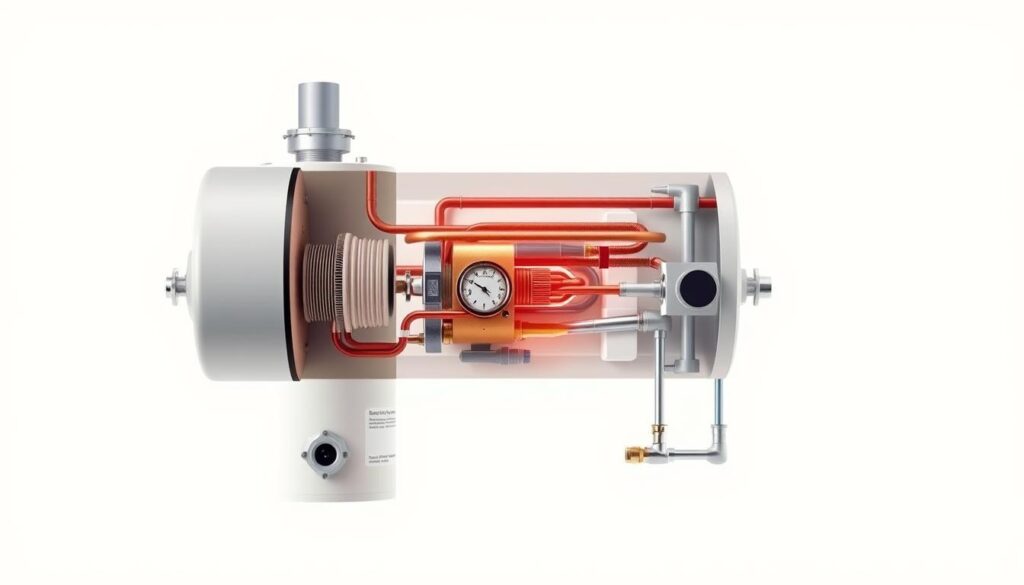
A malfunctioning water heater can disrupt daily routines, making it essential to troubleshoot and repair it promptly. Water heater issues can range from a lack of hot water to leaks and unusual noises. Understanding the root cause of the problem is crucial for effective repairs.
Troubleshooting Common Issues
The first step in addressing water heater problems is to identify the symptoms. Common issues include inadequate hot water, leaks around the heater, or strange noises coming from the unit. Checking the power source, thermostat settings, and the condition of the heating elements can help diagnose the problem. For complex issues, it may be necessary to consult a professional for emergency plumbing services.
Flushing the Water Heater
Flushing the water heater is a maintenance task that can help improve its efficiency and longevity. Sediment buildup can cause the heater to work harder, leading to increased energy bills and potentially causing the heater to fail prematurely. To flush the water heater, turn off the power supply, connect a hose to the drain valve, and allow the water to drain out. This process can help remove sediment and debris that may be causing issues.
Checking the Thermostat
The thermostat is a critical component of the water heater, as it controls the temperature of the water. If the thermostat is set too high, it can lead to scalding hot water, while a setting that’s too low may not provide sufficiently hot water. Checking and adjusting the thermostat can often resolve temperature-related issues. It’s also important to ensure that the thermostat is functioning correctly and not causing the heater to malfunction.
In conclusion, addressing water heater problems requires a systematic approach that includes troubleshooting, maintenance tasks like flushing the heater, and checking critical components such as the thermostat. By following these steps, homeowners can often resolve common issues and ensure their water heater operates efficiently. For more complex problems or when in doubt, seeking same-day plumbing repairs from a professional can prevent further damage and ensure safety.
Basic Pipe Repairs
Understanding how to repair pipes is essential for maintaining a home’s plumbing system efficiently. Basic pipe repairs can save homeowners from the hassle and expense of calling a professional for every minor issue.
Patching Leaks with Epoxy
One of the most effective methods for repairing leaks in pipes is by using epoxy. Epoxy is a strong adhesive that can bond with various materials, including metal and PVC. To patch a leak, clean the area around the leak thoroughly, mix the epoxy according to the manufacturer’s instructions, and apply it to the damaged area. Allow the epoxy to dry completely before turning on the water supply. This method is particularly useful for affordable plumbing fixes, as it eliminates the need for immediate replacement.
Using Pipe Sleeves
Pipe sleeves are another solution for repairing damaged pipes. A pipe sleeve is essentially a cover that fits over the damaged section of the pipe, providing a seal that prevents further leakage. To use a pipe sleeve, measure the diameter of the pipe, cut the sleeve to the appropriate length, and secure it in place using the provided fasteners or adhesives. Pipe sleeves are a quick fix that can be very effective for minor damages.
Replacing Damaged Sections
In cases where the damage to the pipe is extensive, it may be necessary to replace the damaged section entirely. This involves cutting out the damaged part of the pipe and installing a new section. To do this, turn off the water supply, cut the pipe using a pipe cutter, and remove the damaged section. Then, measure and cut a new piece of pipe to fit, and connect it using appropriate fittings and adhesives. For complex replacements, it might be wise to consult plumbing repair services to ensure the job is done correctly.
By mastering these basic pipe repair techniques, homeowners can ensure their plumbing system remains in good condition, reducing the likelihood of major issues arising in the future. Regular maintenance and prompt repairs are key to avoiding costly fixes down the line.
Simple Toilet Repairs
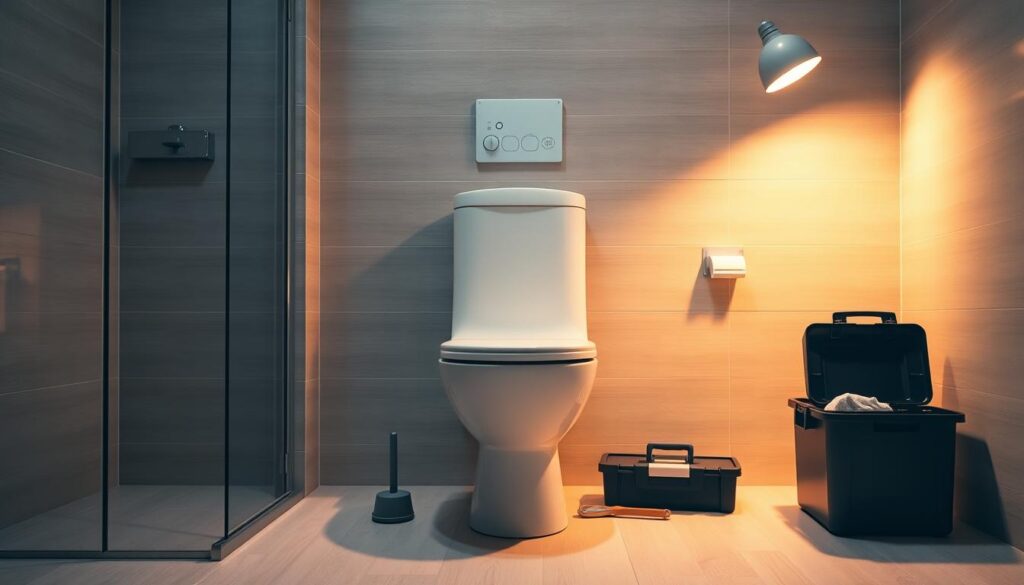
Understanding how to perform simple toilet repairs can significantly reduce maintenance costs and prevent more extensive plumbing issues. Toilets are among the most frequently used fixtures in our homes, and knowing how to address common problems can save time and money.
Replacing the Toilet Seat
Replacing a toilet seat is a straightforward process that requires minimal tools. First, ensure you purchase a seat that matches your toilet’s specifications. To begin, turn off the water supply to the toilet and flush it to drain the tank and bowl. Then, unscrew the bolts holding the old seat in place. Remove the old seat and replace it with the new one, securing it with the provided bolts. For more detailed instructions, you can visit Lowe’s guide on common toilet problems.
Fixing a Stuck Flapper
A stuck flapper can cause continuous running of water into the toilet bowl, wasting water and increasing your utility bills. To fix this, first, turn off the water supply and flush the toilet. Inspect the flapper for any debris or mineral buildup that might be causing it to stick. Clean the flapper and its seat, or replace it if necessary. Adjusting or replacing the flapper can often resolve the issue, providing a fast plumbing solution to a potentially wasteful problem.
Repairing the Tank
The toilet tank is a critical component, and issues here can lead to various problems, including leaks and continuous running. To repair the tank, start by identifying the source of the issue. Check for cracks, worn-out flappers, or faulty fill valves. For leaks, you may need to replace the flapper or adjust the fill valve. In cases of cracks, applying a sealant or replacing the tank might be necessary. Ensuring the tank is in good condition is crucial for the overall efficiency of the toilet, making it an essential part of maintaining an efficient plumbing repair company-recommended system.
By addressing these simple repairs, homeowners can avoid more significant issues down the line, ensuring their toilet operates efficiently and effectively. Regular maintenance and prompt repairs are key to a well-functioning plumbing system.
Maintaining Your Plumbing System
To ensure your plumbing system operates efficiently, regular maintenance is key. A well-functioning plumbing system not only saves water but also prevents costly repairs down the line.
Regular Inspection Practices
Regular inspections are crucial for identifying potential issues before they become major problems. Homeowners should check for leaks under sinks, around toilets, and near water heaters. It’s also wise to inspect the condition of pipes, especially in older homes where corrosion might be a concern.
By catching issues early, you can avoid the need for same-day plumbing repairs, which can be costly and inconvenient.
Importance of Drain Cleaning
Drain cleaning is another vital aspect of plumbing maintenance. Clogged drains can lead to backups, odors, and even damage to your pipes. Regularly cleaning your drains with a plunger or a drain snake can help prevent these issues.
For more thorough cleaning, consider using a baking soda and vinegar solution. This natural method can help clear buildup without damaging your pipes. If you’re unsure about how to clean your drains effectively, consider consulting an expert plumber near me for professional advice.
Checking for Pipe Corrosion
Pipe corrosion is a serious issue that can lead to leaks, contamination, and significant repair bills. Regularly checking your pipes for signs of corrosion, such as rust or discoloration, can help you address the problem before it escalates.
If you suspect your pipes are corroded, it’s essential to act quickly. Consulting a professional plumber for an assessment and potential replacement can save you from more extensive damage and the need for emergency same-day plumbing repairs.
By following these maintenance tips, homeowners can ensure their plumbing systems remain in good condition, reducing the likelihood of unexpected repairs and maintaining the overall integrity of their home’s plumbing.
Winterizing Your Plumbing
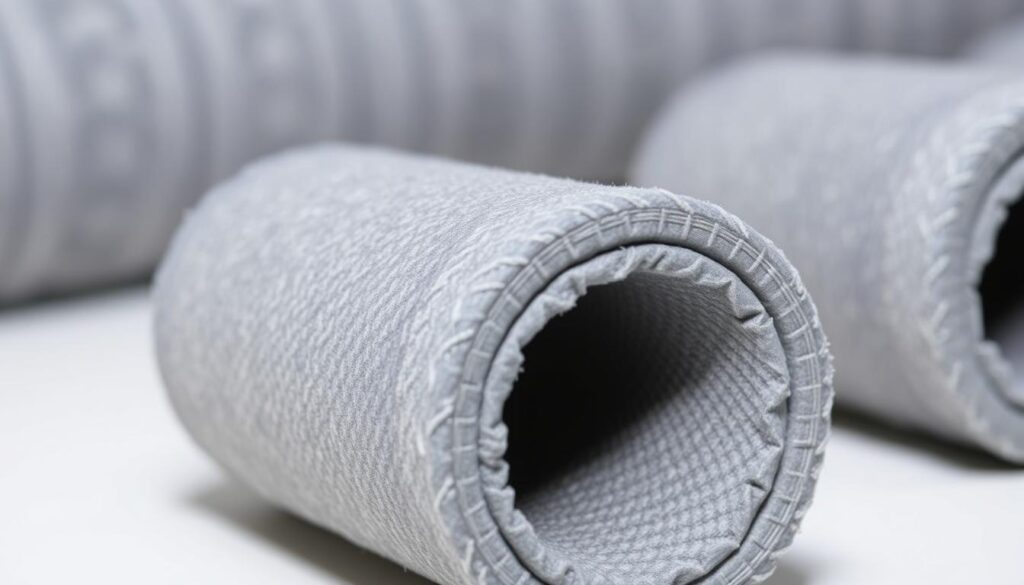
As winter approaches, homeowners must take proactive steps to protect their plumbing systems from freezing temperatures. Winterizing your plumbing is crucial for preventing costly damages and ensuring your home remains functional throughout the cold season.
Insulating Pipes
One of the most effective ways to winterize your plumbing is by insulating exposed pipes in unheated areas such as the garage, basement, or crawlspace. Pipe insulation can be purchased at most hardware stores and is relatively easy to install. By wrapping your pipes with insulation, you can significantly reduce the risk of them freezing and bursting.
Draining Outdoor Faucets
Outdoor faucets are particularly vulnerable to freezing temperatures. To prevent damage, it’s essential to drain and disconnect hoses from outdoor faucets. Consider installing freeze-proof faucets or frost-proof spigots, which are designed to withstand cold temperatures. If you live in an area prone to harsh winters, you may also want to consider shutting off the water supply to outdoor faucets from inside your home.
Preventing Frozen Lines
In addition to insulating pipes and draining outdoor faucets, there are several other measures you can take to prevent frozen lines. Letting cold water drip from faucets served by exposed pipes can help prevent freezing. You can also open cabinet doors under sinks to allow warm air to circulate around the pipes. For added protection, consider using emergency plumbing services to inspect your plumbing system before winter sets in.
By taking these steps, you can help ensure your plumbing system remains safe and functional throughout the winter months. If you do experience any issues, don’t hesitate to contact plumbing repair services for professional assistance.
When to Call a Professional
Not all plumbing issues can be resolved with DIY fixes; knowing when to seek professional help is crucial. While attempting to fix problems yourself can be cost-effective, some situations require the expertise of an efficient plumbing repair company to avoid further damage and ensure a lasting solution.
Signs You Need Expert Help
There are several indicators that suggest it’s time to call a professional plumber. These include complex issues that you’re not familiar with, significant water damage, or uncertainty about the repair process. If you notice any of these signs, it’s wise to seek help from an experienced plumber who can provide affordable plumbing fixes.
- Persistent leaks or water damage
- Complex pipe issues or burst pipes
- Uncertainty about the repair or maintenance needed
Assessing Repair Difficulty
Before deciding to call a professional, assess the difficulty of the repair. Consider the complexity of the issue, the tools required, and your level of comfort with the repair. If the task seems too challenging or you’re unsure about how to proceed, it’s best to consult a professional. An efficient plumbing repair company can quickly diagnose the problem and provide a suitable solution.
Understanding Costs
Understanding the costs associated with hiring a professional plumber is essential. Factors that influence the cost include the complexity of the repair, the plumber’s rates, and any additional materials needed. While it may seem more expensive upfront, hiring a professional can save you money in the long run by preventing further damage and ensuring the job is done correctly. Look for a company that offers affordable plumbing fixes without compromising on quality.
In conclusion, knowing when to call a professional plumber is vital for addressing complex plumbing issues effectively. By recognizing the signs that indicate the need for expert help, assessing the difficulty of repairs, and understanding the associated costs, homeowners can make informed decisions about when to seek professional assistance.
Eco-Friendly Plumbing Solutions
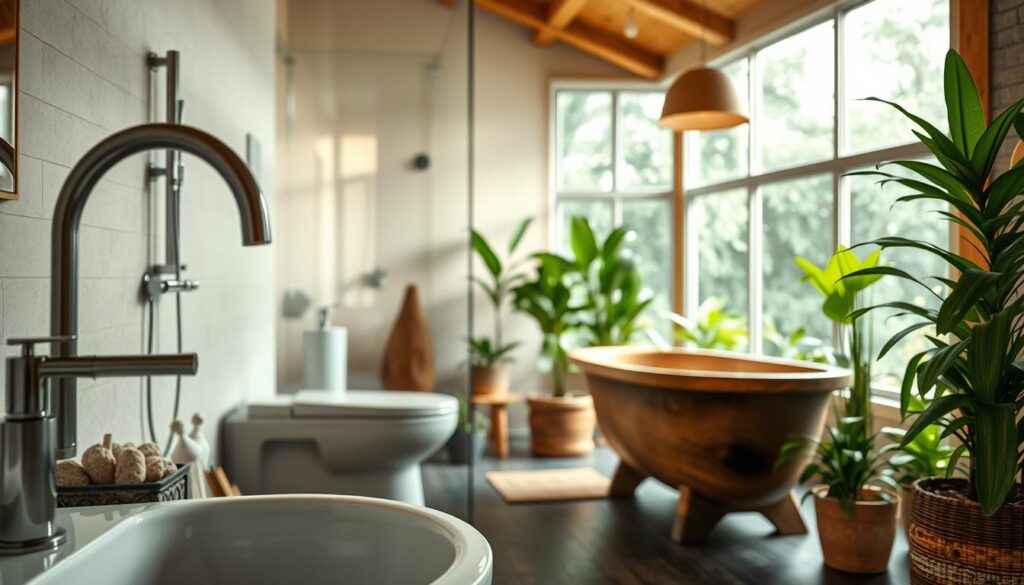
As homeowners, we have the power to make a positive impact on the environment by adopting eco-friendly plumbing solutions. By making a few simple changes to our plumbing systems, we can significantly reduce our household’s environmental footprint.
Water-Saving Fixtures
One of the most effective ways to reduce water waste is by installing water-saving fixtures. These fixtures are designed to use significantly less water while maintaining their functionality. Some examples include:
- Low-flow showerheads
- Dual-flush toilets
- Faucet aerators
By incorporating these fixtures into our homes, we can conserve water and reduce our water bills.
Using Natural Drain Cleaners
Chemical drain cleaners can be harsh on our pipes and the environment. Instead, we can use natural drain cleaners that are just as effective. Some options include:
- Baking soda and vinegar
- Boiling water
- Enzyme-based cleaners
These natural cleaners are not only better for the environment, but they are also safer for our pipes and can help prevent clogs.
Benefits of Composting Toilets
Composting toilets are a revolutionary solution for households looking to reduce their water usage and waste. These toilets use natural processes to decompose human waste, reducing the need for water and minimizing the amount of waste sent to landfills.
Some benefits of composting toilets include:
- Significant water savings
- Reduced waste sent to landfills
- Creation of nutrient-rich compost
While composting toilets may require a larger upfront investment, they offer a sustainable solution for households looking to reduce their environmental impact.
Emergency Plumbing Tips
When disaster strikes your plumbing system, having the know-how to act quickly is crucial. Plumbing emergencies can cause significant damage if not handled properly, but with the right knowledge, homeowners can mitigate the issue until an expert plumber near me can be called.
Shut Off Valves
One of the first steps in managing a plumbing emergency is knowing how to shut off the main water supply. This can be done by locating the main shut-off valve, typically found near the water meter or where the water line enters the home. Turning this valve clockwise will shut off the water supply to the house, preventing further damage from burst pipes or leaks. It’s essential to familiarize yourself with the location and operation of this valve to act swiftly in an emergency.
Handling Burst Pipes
Burst pipes are a common plumbing emergency that can cause extensive water damage. If a pipe bursts, the first step is to shut off the main water supply immediately. Next, switch off the electricity in areas where water has flooded to prevent electrical shock. Then, call an emergency plumbing services provider to repair or replace the damaged pipe. In the meantime, use buckets or towels to contain the water and minimize damage.
Immediate Steps for Flooding
In the event of flooding due to a plumbing issue, quick action is vital. After shutting off the main water supply, remove any valuable or electrical items from the flooded area to prevent damage. Use a wet/dry vacuum or towels to start drying the area. It’s also crucial to identify and address the source of the flood. If the issue is beyond your control, don’t hesitate to contact emergency plumbing services for professional assistance.
By being prepared and knowing how to react in a plumbing emergency, homeowners can reduce the risk of significant damage and costly repairs. Regularly checking your plumbing system and knowing when to call for professional help can make all the difference in managing emergencies effectively.
Conclusion: Embracing DIY Plumbing
By mastering quick and easy plumbing repairs, homeowners can significantly reduce their reliance on plumbing repair services, leading to substantial cost savings. This guide has equipped you with the knowledge to tackle common plumbing issues, from leaky faucets to clogged drains.
Gaining hands-on experience with DIY plumbing repairs not only boosts confidence but also fosters a deeper understanding of your home’s plumbing system. As you become more comfortable with basic repairs, you’ll be better equipped to identify potential issues before they escalate into major problems.
Long-term Benefits
Embracing DIY plumbing repairs can have long-term benefits, including reduced maintenance costs and increased property value. By adopting sustainable practices, such as using eco-friendly fixtures and natural drain cleaners, homeowners can also contribute to a more environmentally friendly household.
Sustainable Practices
Promoting sustainable practices through DIY plumbing repairs is not only beneficial for the environment, but it also enhances the overall efficiency of your plumbing system. By incorporating water-saving fixtures and adopting eco-friendly habits, homeowners can make a positive impact while enjoying the benefits of quick and easy plumbing repairs.
